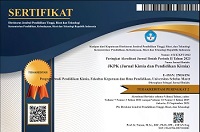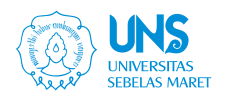Measuring Students' Perceptions of Constructivist Learning Environments Linked to Understanding of Rasch Modeling-Based Chemical Concepts
Abstract
This study aims to evaluate the suitability of data obtained from the Constructivist Learning Environment Survey instrument and a multiple-choice chemistry understanding test, as well as to examine the relationship between students' perceptions of the constructivist learning environment and their understanding of chemistry concepts. A non-experimental, quantitative descriptive approach was employed, involving 519 12th-grade science students from five high schools in Gorontalo Province during the even semester of the 2024/2025 academic year. Data analysis was conducted using the Rasch model via Winsteps 3.73 software to assess instrument quality, and SPSS software to test data normality and analyze correlations. The results indicated that both instruments were valid and reliable, with person reliability of 0.81, item reliability of 0.99, and Cronbach’s Alpha exceeding 0.80—classified as excellent. A Pearson correlation analysis revealed that the calculated r value exceeded the critical value (rcount= 0.135 > rtable= 0.087), indicating a statistically significant, albeit weak, positive relationship between students’ perceptions and their chemistry understanding. The hypothesis testing results showed that the null hypothesis (H₀) was rejected and the alternative hypothesis (H₁) was accepted, confirming the existence of a relationship between students’ perceptions of constructivist learning environments and their understanding of chemistry concepts.
Keywords
Full Text:
PDFReferences
[1] Adu-Gyamfi, K., Ampiah, J. G., & Agyei, D. D. (2020). Participatory teaching and learning approach: A framework for teaching redox reactions at high school level. International Journal of Education and Practice, 8(1), 106–120. https://doi.org/10.18488/journal.61.2020.81.106.120
[2] Almubarak, A., Saadi, P., Prayogi, R., & Maldini, P. P. (2023). Assessing students' understanding of chemical bonds material by Rasch modeling. Indonesian Journal on Learning and Advanced Education (IJOLAE), 5(3), 217–232. https://doi.org/10.23917/ijolae.v5i3.22242
[3] Avinç, E., & Doğan, F. (2024). Digital literacy scale: Validity and reliability study with the Rasch model. Education and Information Technologies, 29(17), 22895–22941. https://doi.org/10.1007/s10639-024-12662-7
[4] Boone, W. J., Townsend, J. S., & Staver, J. (2011). Using Rasch theory to guide the practice of survey development and survey data analysis in science education and to inform science reform efforts: An exemplar utilizing STEBI self-efficacy data. Science Education, 95(2), 258–280. https://doi.org/10.1002/sce.20413
[5] Darmana, A., Sutiani, A., Nasution, H. A., Ismanisa, I., & Nurhaswinda, N. (2021). Analysis of Rasch model for the validation of chemistry national exam instruments. Jurnal Pendidikan Sains Indonesia, 9(3), 329–345. https://doi.org/10.24815/jpsi.v9i3.19618
[6] Easton, V. A. K. (2025). Effect of laboratory manual layout: Does experiential learning benefit from authentic context? Access Microbiology, 7(6). https://doi.org/10.1099/acmi.0.000955.v4
[7] Fraser, B. J. (2012). Classroom learning environments: Retrospect, context, and prospect. In B. J. Fraser, K. G. Tobin, & C. J. McRobbie (Eds.), Second international handbook of science education (pp. 1191–1239). Springer.
[8] Goes, L. F., Chen, X., Nogueira, K. S. C., Fernandez, C., & Eilks, I. (2020). An analysis of the visual representation of redox reactions and related content in Brazilian secondary school chemistry textbooks. Science Education International, 31(3), 313–324. https://doi.org/10.33828/sei.v31.i3.10
[9] Hari, H. P. S., Astuti, S. I. D., & Mulyani, E. (2023). Penskoran yang fair pada tes matematika berbentuk pilihan ganda menggunakan item response theory. JMPM: Jurnal Matematika dan Pendidikan Matematika, 8(2), 157–172. https://doi.org/10.26594/jmpm.v8i2.3293
[10] Hancock, L. M. (2024). Student perceptions of team-based learning in an advanced inorganic chemistry course. Journal of Chemical Education, 101(3), 910–920. https://doi.org/10.1021/acs.jchemed.3c00655
[11] Ilhan, N., Yildirim, A., & Yilmaz, S. S. (2016). The effect of context-based chemical equilibrium on grade 11 students’ learning, motivation, and constructivist learning environment. International Journal of Environmental and Science Education, 11(9), 3117–3137. https://doi.org/10.12973/ijese.2016.919a
[12] Jabnabillah, F., & Margina, N. (2022). Analisis korelasi Pearson dalam menentukan hubungan antara motivasi belajar dengan kemandirian belajar pada pembelajaran daring. Retrieved from https://doi.org/
[13] Khotimah, K., Hadi, T. S., & Lestari, I. (2024). Application of the Rasch model in research publications: A bibliometric analysis. Plusminus: Jurnal Pendidikan Matematika, 4(2), 229–240. https://doi.org/10.31980/plusminus.v4i2.1466
[14] Kwan, Y. W. (2021). Exploring the relationships between constructivist learning environment and critical thinking ability of secondary school students. In Education and New Developments 2021 (pp. 457–461). InScience Press. https://doi.org/10.36315/2021end097
[15] Laliyo, L. A. R., La Kilo, A., Paputungan, M., Kunusa, W. R., Dama, L., & Panigoro, C. (2022). Rasch modelling to evaluate reasoning difficulties, changes of responses, and item misconception pattern of hydrolysis. Journal of Baltic Science Education, 21(5), 817–835. https://doi.org/10.33225/jbse/22.21.817
[16] Laliyo, L. A. R., Sumintono, B., & Panigoro, C. (2022). Measuring changes in hydrolysis concept of students taught by inquiry model: Stacking and racking analysis techniques in Rasch model. Heliyon, 8(3). https://doi.org/10.1016/j.heliyon.2022.e09126
[17] Laliyo, L. A. R., Tangio, J. S., Sumintono, B., Jahja, M., & Panigoro, C. (2020). Analytic approach of response pattern of diagnostic test items in evaluating students’ conceptual understanding of characteristics of particle of matter. Journal of Baltic Science Education, 19(5), 824–841. https://doi.org/10.33225/jbse/20.19.824
[18] Laliyo, L. A. R., Utina, R., Husain, R., Umar, M. K., Katili, M. R., & Panigoro, C. (2023). Evaluating students’ ability in constructing scientific explanations on chemical phenomena. Eurasia Journal of Mathematics, Science and Technology Education, 19(9). https://doi.org/10.29333/ejmste/13524
[19] Malone, K. L., Boone, W. J., Stammen, A., Schuchardt, A., Ding, L., & Sabree, Z. (2021). Construction and evaluation of an instrument to measure high school students’ biological content knowledge. Eurasia Journal of Mathematics, Science and Technology Education, 17(12). https://doi.org/10.29333/ejmste/11376
[20] Md-Muziman-Syah, M. M., Muzir, N. S., Abdul Mutalib, H., & Ab. Halim, N. (2021). The quality of life impact refractive correction (QIRC) questionnaire: Validation of the Malay-translated version of the QIRC using Rasch analysis. BMC Ophthalmology, 21(1). https://doi.org/10.1186/s12886-021-02145-5
[21] Mulyanti, S., Nugroho, D. E., & Harahap, L. K. (2023). Student’s chemical bonds concept: Rasch model analysis. International Journal of Chemistry Education Research, 7(1), 33–38. https://doi.org/10.20885/ijcer.vol7.iss1.art6
[22] Nurhasnah, N., Sepriyanti, N., & Kustati, M. (2024). Learning theories according to constructivism theory. Journal International Inspire Education Technology, 3(1), 19–30. https://doi.org/10.55849/jiiet.v3i1.577
[23] Setyorini, A. D., Yamtinah, S., Mahardiani, L., & Saputro, S. (2021). A Rasch analysis of item quality of the chemical literacy assessment for investigating students’ chemical literacy on chemical rate concepts. European Journal of Educational Research, 10(4), 1769–1779. https://doi.org/10.12973/eu-jer.10.4.1769
[24] Siegel, D. A., et al. (2023). Counts, incidence rates, and trends of pediatric cancer in the United States, 2003–2019. Journal of the National Cancer Institute, 115(11), 1337–1354. https://doi.org/10.1093/jnci/djad115
[25] Soeharto, S., & Csapó, B. (2021). Evaluating item difficulty patterns for assessing student misconceptions in science across physics, chemistry, and biology concepts. Heliyon, 7(11). https://doi.org/10.1016/j.heliyon.2021.e08352
[26] Sujatmika, S., Sutarno, M., Masykuri, M., & Prayitno, B. A. (2025). Applying the Rasch model to measure students’ critical thinking skills on the science topic of the human circulatory system. Eurasia Journal of Mathematics, Science and Technology Education, 21(4). https://doi.org/10.29333/ejmste/16221
Refbacks
- There are currently no refbacks.








